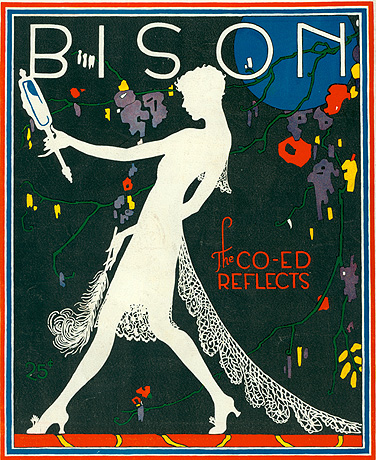Flashback
90 years ago
The Bison: A rambunctious frolic

The February 1927 issue of The Bison, titled “The CO-ED Number,” features a poetic recipe for co-ed success at UB. Photo: UB ARCHIVES
In 1912, UB students in analytical chemistry created and began publication of a humor magazine designed to boost school spirit. Originally named The Condenser and filled with jokes and gossip about collegiate life, within a year the popular publication became The Bison and took on a more polished format. By 1920, The Bison had transformed itself into a glossy magazine, sold on campus and at local newsstands for “two bits” and featuring splashy, often-colorful covers sporting artwork in the “flapper” style of the Roaring Twenties.
Published totally by students under the supervision of the Faculty Committee on Student Activities, The Bisonfhad no literary pretentions. Content focused on graphic cartoons and lots of jokes, generally about drinking and dating. Its humor would be considered quite sexist and racist by today’s standards. As an example, the cover art of the May 1929 “Passing Out Number” depicted a young woman perched on a young man’s lap poring liquor into his mouth through a funnel.
The cover appearing here is from the February 1927 issue, labeled “The CO-ED Number.” Inside is a lengthy poetic recipe for co-ed success at UB. Here are some excerpts:
“If you can wear a boyish bob
And yet be dignified, forsooth;
If you can bluff a hard-boiled prof
As a seeker after truth;
If you can act as if nothing’s wrong
When you enter the classroom late;
If you can write ten thousand words
In an English theme each week;
If you can make all ‘As’ and ‘Bs’
With unadulterated cheek;
Then, my girl, you’ll surely see—
A goodly co-ed you can be.”
—Mercer Cluster
The successful magazine lured extensive advertising, primarily from cigarette brands Old Gold and Chesterfield, local Buffalo clothiers and mechanical engine component manufacturers. Old Gold’s ads were sexually explicit, featuring voluptuous women in scanty, form-fitting evening wear, while the Chesterfield ads portrayed women in a classier, sophisticated context. Ads for the Kleinhans Company consistently featured tuxedos—UB held several formal dances/proms each year in the 1920s-1930s—and a wardrobe of “fine clothes for the man at college” for $40.
The Bison became notorious in the fall of 1932 when the September “Freshman Number” issue published inappropriate commentary about specifically named co-eds affiliated with a sorority. The “slanderous remarks” were considered unworthy of the university. A student lamented the incident in the campus newspaper, The Bee, stating: “By the dragging of personalities in the muck of slander, The Bison has committed literary suicide.” Publication of The Bison was suspended for a year until its revival was approved in 1934 as The New Bison. The title soon reverted to The Bison again and the magazine continued its run until 1941, when it ceased publication in the midst of World War II.
Here is a concluding witticism from the “Prom Number” issue of April 1927, channeling the “good ol’ days” of the fast and carefree 1920s:
“Pretty girls, snappy dancing
Red-hot music and
Oh yes
Money.”
—Judith Adams-Volpe, University Libraries

Reader Comments